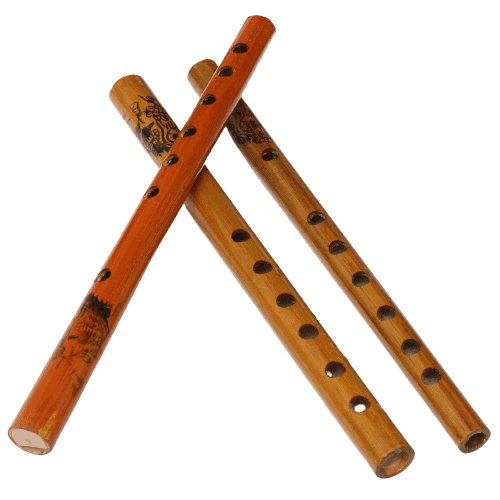This article will give you the basics of how to play the 6 hole bamboo flute, a fascinating instrument, as well as how to make one or where to buy it if you’re really interested in playing it yourself!
Also, by introducing you to some basic information about its history, we hope to give you the motivation and curiosity to start or continue playing such an entertaining instrument.
The History of the Bamboo Flute
The bamboo flute is a beautiful instrument with an ancient history.
The flute itself is one of mankind’s oldest musical instruments. All cultures have developed some form of the flute.
Its simple construction and beautiful tones have fascinated people throughout the ages, being considered as one of the easiest instruments to play in a typical school band.
The history of the bamboo flute dates back to ancient China and Japan. It has been used in many cultures for ceremonial purposes, including Hinduism and Buddhism.
For over 3,000 years people have played the six-hole bamboo flute (also known as a shakuhachi) for spiritual purposes such as prayer or meditation.
In Europe, after the Dark Ages, the flute took the form of a 6 hole wooden instrument of various sizes and pictures. Lighter during the 18th century, additional holes and keys were added resulting in what is nowadays the modern flute.

The six-hole bamboo flute features an open airway for projecting the sound from its four-finger holes (blowhole) and two thumb holes (underneath).
You play this instrument by blowing air into it while covering various combinations of finger holes with your fingers.
Let’s Look at the Various Parts of a Bamboo Flute:
A bamboo flute, also known as a pan flute, can be made from a piece of bamboo and other small pieces of wood or stone.
They are usually cylindrical in shape with six holes for fingers and air passage, as well as one hole for under-blowing (underneath) to produce softer sounds than playing with an uncovered hole or blowing across both blowholes.
- Blowhole: Located at the top of the flute, this is where you blow air into the instrument. It has six holes to cover and uncover with your fingers.
- Under blowhole: This hole is located underneath the six-hole blowhole on the bamboo flute. Covering it can produce a softer sound than playing with an uncovered hole or blowing across both blowholes.
- Mouthpiece: The mouthpiece is located below and in front of all the flutes holes.
How Can I Make My Own Bamboo Flute?
If you have some bamboo, a knife, and an optional small piece of wood or stone (to help hold the flute together), you can make your own bamboo flute.
Bamboo is a versatile material that can be used to make the soundboard, mouthpiece, end cap, and bell of the flute.
Here is a simple to follow instructions video on how to make your own bamboo flute:
How and Where Can I Buy a Bamboo Flute?
A bamboo flute can be purchased at many places including music stores, oriental markets, and online, in specific instrument marketplaces like Reverb.
Like other beginners flutes, it is important to find a flute that is in tune with the keys of your instrument.
You also want to look for instruments made from quality bamboo or other hardwood, as these will be more durable than cheaper bamboo.
How to Play Bamboo Flute for Beginners?
First, you should make sure your hands are warm and moist before playing the instrument.
To play, place fingers over holes according to their size. The thumb should cover one whole hole and all but two fingers should close the other two holes.
Then, blow a gentle breath in the mouthpiece and shake the instrument to create sound.
You might wonder what a will the bamboo flute sounds like?
The answer is that the sound depends on what you’re trying to accomplish.
There is a simple and great resource provided by Ginger Baird, on how to play the 6 hole bamboo flute, which gives you some exercises of well-known songs for you to practice and is ideal for beginners.
How Do I Make a Pan Flute from Bamboo?

Also made from bamboo, you might want to be interested in making or playing your own pan flute.
To make your own pan flute, start by slicing off the bottom end of a clean piece of bamboo. This will serve as the mouthpiece for your instrument.
Next, use any type of blade or saw to cut six thin slits up each side of one long side of the bamboo until you reach its top edge.
Then cut out the top of the bamboo so that it’s about 1 inch wide.
Once you have done this, cut slits into the bottom half in a similar manner to those on the side until you reach its center. This will create six holes for sound waves to travel through.
